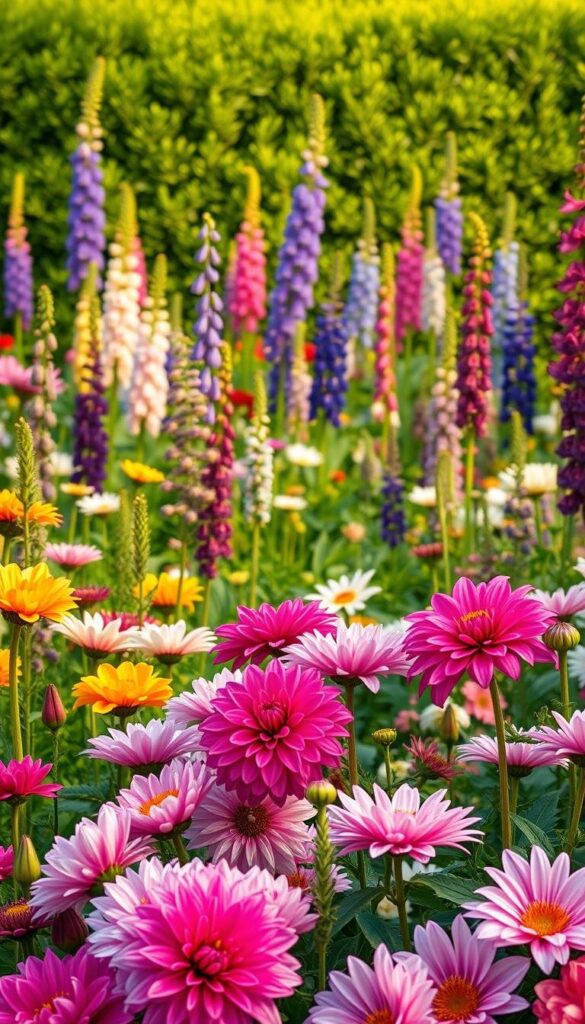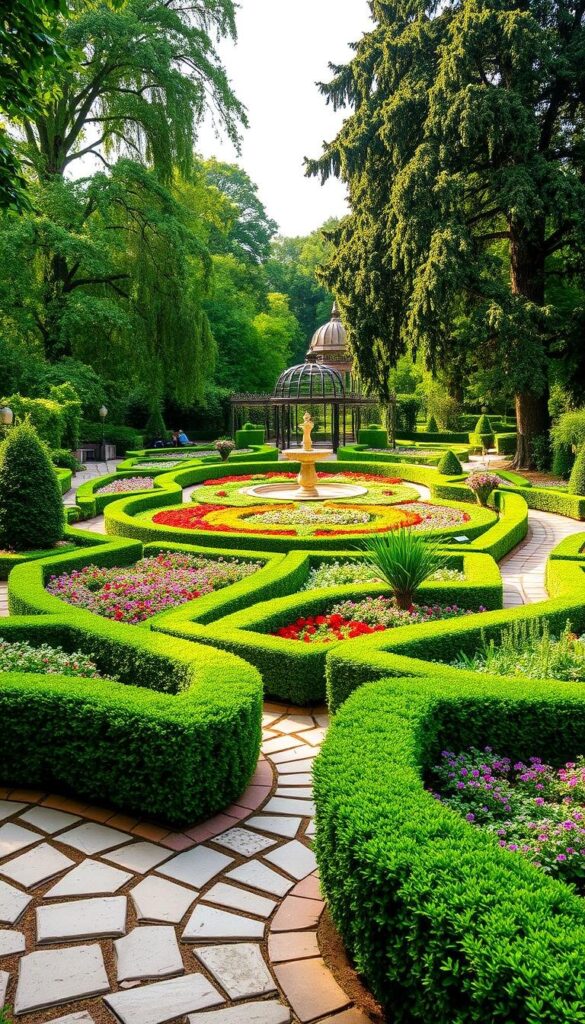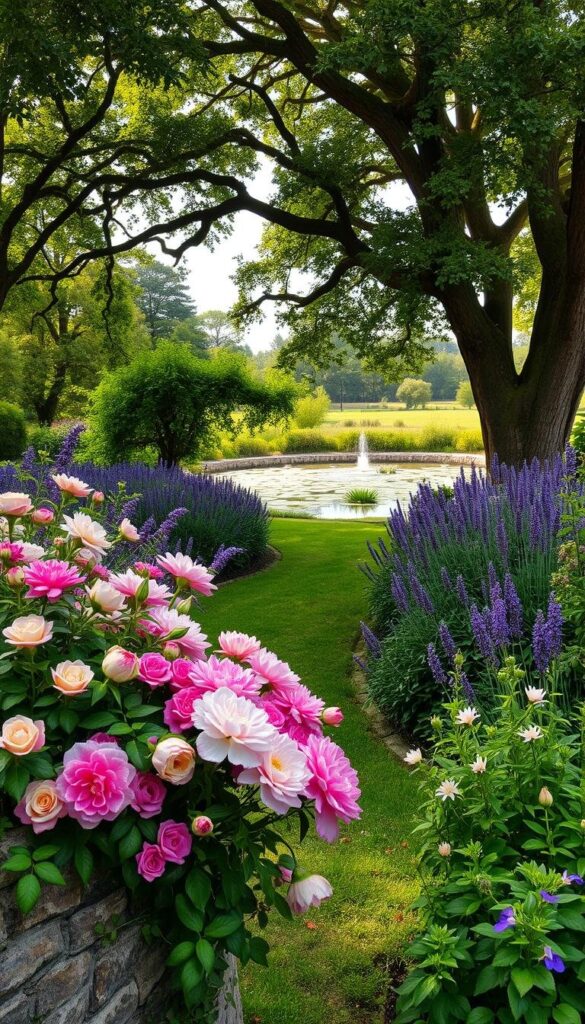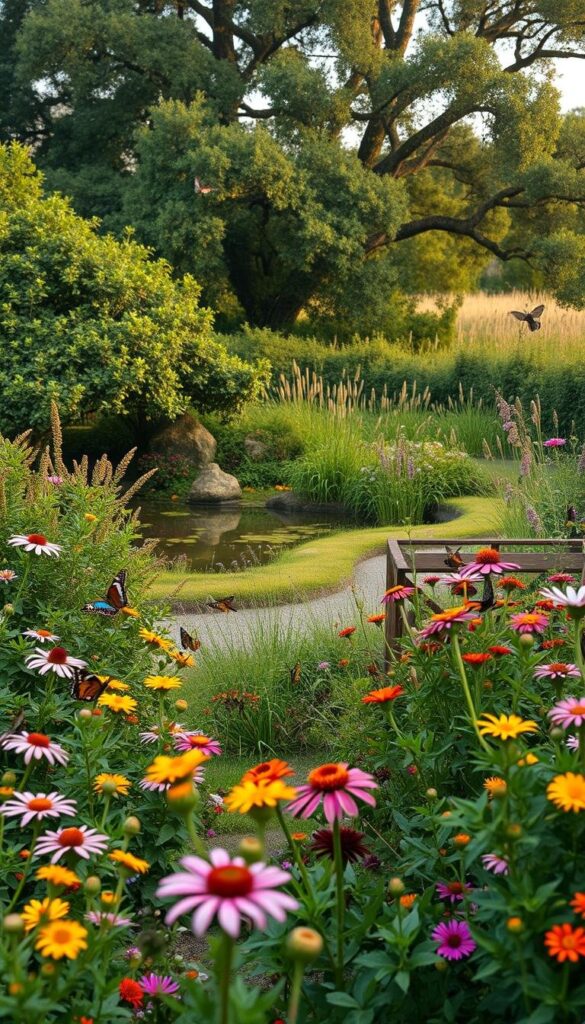This post may contain affiliate links. If you click and buy, we may earn a small commission at no extra cost to you. Learn more.
English Flower Gardens are a mix of timeless beauty and nature’s charm. Imagine seeing vibrant blooms, fragrant roses, and neatly trimmed hedges. They create a peaceful retreat that has captivated people for centuries.
These gardens offer a blend of tradition and creativity. Whether you dream of a cottage-style paradise or a structured floral display, they connect us to history and nature. Learn how to design spaces that feel both personal and part of a cherished gardening legacy.
Contents
- 1 Introduction to English Flower Gardens
- 2 Choosing the Right Location for Your Garden
- 3 Essential Flowers for Your English Garden
- 4 Designing Your Flower Garden Layout
- 5 Incorporating Natural Elements
- 6 Attracting Wildlife to Your Garden
- 7 Maintenance Tips for Your English Flower Garden
- 8 Seasonal Care for Flowers
- 9 Expanding Your Garden with Edibles
- 10 Creating a Sustainable Flower Garden
- 11 Hosting Garden Events
- 12 Conclusion: Your Personal English Garden Awaits
Introduction to English Flower Gardens
English flower gardens mix art and nature to make peaceful and beautiful spaces. They have changed over centuries, shaping how we think about outdoor living. At their heart, they focus on beautiful flower beds and careful garden design. They balance wild beauty with planned structure.
A Brief History
These gardens started in medieval monastery gardens, with a focus on herbs and medicine. By the 18th century, they moved to more romantic styles. Later, Gertrude Jekyll and William Robinson pushed for naturalistic designs, using plants that fit local climates well.
Their work laid down rules we see today, like using different plants for each season.
Key Characteristics
English gardens are known for:
- Informal plant groupings that look like nature
- Rich colors like lavender and pink
- Layered plants that bloom all year
- Paths through beautiful flower beds for exploring
These features turn land into living art, where garden design seems easy yet thoughtful. Whether it’s roses or wildflowers, the aim is to make spaces that feel both planned and wild.
Choosing the Right Location for Your Garden
Starting a lush garden begins with finding the best spot. Sunlight, soil, and space are essential for plant growth. Look at your yard’s features to see where flowers will do well.

Assessing Sunlight and Shade
Watch how sunlight moves across your yard each day. Note which spots get full sun, partial shade, or are always shady. Morning sun is good for plants like peonies, while afternoon shade protects them from heat.
Keep a notebook to track changes in sunlight over time. Spring and summer light patterns are different, so it’s important to note them.
Soil Quality and Preparation
Good soil is key for healthy flowers. Use a soil test kit from brands like Luster Leaf or Miracle-Gro. Most English garden plants prefer a pH between 6.0–7.0.
Make dry soil better with compost or aged manure. Add sand to clay soil to improve drainage. Mix in organic matter to boost nutrients.
- Test soil every 2 years for ongoing health
- Drainage holes in beds prevent root rot
- Rake soil smooth before planting
By following these steps, you can create a beautiful English garden. With careful planning, your garden will flourish with classic beauty.
Essential Flowers for Your English Garden
Every English garden is a mix of classic and bold plants. These plants create lush, layered landscapes that remind us of the countryside. Whether you want traditional charm or color all year, picking the right plants makes your garden welcoming and easy to care for.

Classic Choices: Roses and Lavender
Roses and lavender are key for garden structure and scent. Climbing roses like ‘New Dawn’ flow over arches, while shrub roses like ‘English Rose Collection’ bloom again and again. Lavender, like ‘Hidcote’, brings a sweet scent and stands tall. Both are easy to care for and bloom every year, adding color reliably.
- Roses: Prune in late winter for fuller growth
- Lavender: Thrives in sunny, well-drained soil
Vibrant Additions: Poppies and Hollyhocks
Common poppies and tall hollyhocks (Alcea rosea) bring bold colors like red, pink, and white. Their bright flowers draw the eye up, creating interesting contrasts. Poppies spread on their own, and hollyhocks can grow up to 6 feet, great for the back of your garden.
Seasonal Blooms for Year-Round Interest
For blooms all year, mix different plants:
- Spring: Daffodils and crocus
- Summer: Peonies and delphiniums
- Fall: Chrysanthemums and sedums
Add evergreen shrubs like boxwood to keep your garden looking good in winter.
Designing Your Flower Garden Layout
Creating an English flower garden that looks effortlessly natural requires careful garden design. It’s all about finding the right balance between structure and spontaneity. This balance is key to achieving that classic charm. Let’s explore how to shape your space without losing that wildflower magic.
The Importance of Structure
Every great garden starts with a framework. Elements like stone paths, boxwood hedges, or rustic arbors act as anchors. These structures give order to the chaos of blooming flowers. Start by mapping out pathways first—they dictate how visitors move through your space. A wooden bench or a focal statue adds purpose to open areas.
- Paths: Use gravel or brick for durability and charm.
- Hedges: Boxwood or yew create living borders without looking rigid.
- Focal points: A water fountain or trellis draws the eye toward key areas.
Creating Visual Harmony
Balance is the secret to cohesive garden design. Think of color like a painter: cool blues and whites near the house, transitioning to warm reds and yellows in wilder sections. Follow these principles:
- Rhythm: Repeat plant groupings to guide the eye.
- Scale: Avoid overwhelming small spaces with towering shrubs.
- Sight lines: Keep vistas open to emphasize focal points.
“A well-designed garden should feel like a living painting—structured yet alive.” – Rachel Armstrong, Landscape Architect

Sketch your layout on graph paper first. Bubble diagrams help visualize activity zones (like seating areas) versus planting beds. Remember: formal symmetry near the home softens into wilder growth as you move outward. This time-honored approach keeps your garden looking both intentional and unforced.
Incorporating Natural Elements
Make your English flower garden better by mixing hardscaping with nature. Pathways and water features bring harmony to any lush garden landscape. They invite people to explore and relax.

Pathways and Walkways
Choose materials that match your garden’s style. Here are some options:
- Gravel: Adds texture and rustic charm for informal layouts
- Brick: A timeless choice for formal lush garden landscape designs
- Flagstone: Creates geometric patterns that guide foot traffic
- Grass paths: Soft, low-maintenance routes for cottage gardens
Curved paths encourage exploration, while straight lines add structure. Mulch or edging keeps weeds away.
Water Features for Tranquility
Water brings life to outdoor spaces. Consider these options:
- Birdbaths: Attract pollinators and birds
- Reflecting pools: Mirror surroundings for dramatic effect
- Fountains: Gentle splashes create soothing soundscapes
- Mini streams: Use pebbles and native plants for natural flow
“A well-placed fountain turns a garden into a sanctuary,” says the Royal Horticultural Society.
Place water features where they’re visible from seating areas. Use pumps for small ponds and check liners yearly. These elements attract wildlife and enhance the garden’s sensory experience. Proper maintenance keeps both pathways and water features looking fresh all year.
Attracting Wildlife to Your Garden
Turn your backyard into a thriving ecosystem with backyard garden inspiration that supports local wildlife. An English flower garden is more than just beautiful—it’s a living community. By welcoming birds, bees, and butterflies, you help pollinate and create a sanctuary that’s both beneficial and beautiful.

Birds and Bees: The Benefits of Biodiversity
Flowers like lavender and sunflowers attract pollinators, while berry bushes feed birds. Backyard garden inspiration flourishes when plants support local ecosystems. Hummingbirds drink nectar from foxgloves, and ladybugs eat aphids, reducing pesticide use. This natural balance makes your garden self-sustaining.
“A garden without wildlife is like a symphony missing its melody.” — The Royal Horticultural Society
Creating Safe Habitats
- Install nest boxes for bluebirds or wrens in shaded tree branches.
- Hang bee hotels filled with hollow bamboo stalks for solitary bees.
- Leave leaf litter under hedges—these microhabitats shelter overwintering insects.
- Plant thorny shrubs like hawthorn to create hidden nesting spots.
Small changes can have a big impact. A dish of water near flowers becomes a birdbath; a pile of stones offers sun-warmed spots for butterflies. These elements transform your garden into a sanctuary that supports conservation goals and adds life to every corner.
Maintenance Tips for Your English Flower Garden
Regular care keeps your English garden lively and charming. These flower gardening tips mix beauty with practicality. They help plants stay healthy all year round.

“A well-maintained garden is a living painting, requiring both artistry and attention.” — Royal Horticultural Society
Watering and Fertilization Techniques
Good watering is key to avoid too much or too little water. Use soaker hoses or drip systems to water roots directly. Check soil moisture by poking it 2 inches deep.
If it’s dry, it’s time to water. Adjust how often you water with the seasons. Water more in summer and less in winter. For feeding, add compost in spring and balanced fertilizer in early summer. Always follow the package instructions to avoid too much fertilizer.
Pest Management Strategies
- Plant pest-resistant varieties like lavender or marigolds.
- Handpick larger pests like slugs and drop them in soapy water.
- Introduce ladybugs or praying mantises to control aphids naturally.
- Use neem oil or insecticidal soap as a last resort for persistent issues.
Keep your garden clean—remove dead leaves and weeds. This makes it harder for pests to hide. Regular checks help find problems early, making fixes easier.
By following these flower gardening tips, your garden will flourish. It will stay true to the English style’s relaxed elegance.
Seasonal Care for Flowers
Mastering seasonal planting makes your garden bloom all year. By following nature’s cycles, you create a lively, green space. Start by making a calendar for planting and upkeep.
Spring Planting Essentials
- Divide crowded perennials like hostas and daylilies for better growth.
- Start seeds indoors for annuals like marigolds and zinnias. Then, harden them off before moving them outside.
- Plant summer-blooming bulbs (like dahlias) and add mulch to keep soil moist.
Autumn Cleanup and Preparation
- Trim dead foliage from perennials but keep seed heads like sunflowers for birds.
- Mulch beds with compost or straw to protect roots without blocking them.
- Plant tulip and crocus bulbs in October for spring seasonal planting shows.
Keep your garden neat but also think about wildlife. Leave leaf piles for insects. Use USDA hardiness zone guides to avoid frost. A smart plan turns chores into garden renewal chances.
Expanding Your Garden with Edibles
Turn your garden into a place that looks great and grows food. Mix edible plants with flowers for a backyard garden inspiration inspired by English cottage gardens. This mix of colors and usefulness doesn’t take up too much space.
Mixing Flowers with Herbs and Vegetables
Make your garden both useful and pretty by arranging plants in creative ways:
- Use lettuce varieties with ruffled edges as colorful borders.
- Train fruit trees against walls using espalier techniques to save space.
- Plant basil or sage as aromatic, flowering accents.
Companion Planting for Healthier Growth
Strategically pair plants to improve health and keep pests away:
- Marigolds near tomatoes repel nematodes and add orange blooms.
- Nasturtiums near cabbage deter aphids while providing edible blossoms.
- Rosemary’s scent masks vegetable scents, confusing pests.
“A well-planned edible garden is a living mosaic of purpose and beauty.”
Try these ideas to keep the cottage garden tradition alive while enjoying fresh food. Every bed becomes a dual-purpose masterpiece, giving backyard garden inspiration for small spaces. Let herbs and vegetables be the stars without losing style.
Creating a Sustainable Flower Garden
Eco-friendly flower gardening tips mix old traditions with new green values. Choose plants that need less water, like lavender or coneflowers. This cuts down on water use.
Mulching keeps the soil moist and cool. It also reduces waste. Instead of chemical pesticides, use natural methods like ladybugs or neem oil.
“Sustainable gardens aren’t just beautiful; they’re a promise to future generations.” — Royal Horticultural Society
Eco-Friendly Gardening Practices
- Use rain barrels to collect water for irrigation
- Plant native species that thrive without extra care
- Rotate crops annually to prevent soil depletion
Composting and Recycling
Make compost from kitchen scraps and garden trimmings. Here’s how:
- Layer brown materials (dried leaves) and green waste (vegetable peelings)
- Aerate the pile weekly to speed decomposition
- Use finished compost as fertilizer in spring
Use recycled items like broken pots for edging or old barrels as planters. These tips help create a system that’s good for the planet. They honor English garden history while making our planet healthier.
Hosting Garden Events
Make your English garden a place for fun with events that show off its beauty. You can invite friends or join local gatherings. Your garden can become a spot for happiness and connection.
Tips for Perfect Outdoor Gatherings
Plan your events when vibrant floral displays are at their best. This will make your garden look amazing. Here are some key things to remember:
- Seating: Place cushions under canopies or arbors for comfy spots.
- Lighting: Use string lights or lanterns to brighten things up at night.
- Weather prep: Have tents or shaded areas ready for any weather.
- Activity zones: Set up different areas for eating, playing games, and talking quietly.
Showcasing Your English Garden
Show off your garden’s highlights by timing events during peak bloom times. For instance, have a summer evening event when roses and peonies are blooming.
“A well-timed garden tour can turn visitors into lifelong admirers,” says the Royal Horticultural Society.
Give guided tours to highlight special plants or design parts. Share your garden’s beauty by:
- Hosting a small open garden day for neighbors.
- Sharing photos on social media with #EnglishGardenMagic.
- Joining local garden club tours to inspire others.
Every event is a chance to enjoy your garden and build community through nature’s beauty.
Conclusion: Your Personal English Garden Awaits
Starting an English Flower Garden is a journey of patience and passion. It connects you deeply with nature. Every step you take makes your garden more beautiful.
Finding Inspiration and Community
Visit places like Longwood Gardens or the Chicago Botanic Garden. See English Flower Garden designs up close. Books like “The English Flower Garden” by William Robinson and online forums like GardenWeb offer great advice.
Join local horticulture clubs to share ideas and progress. These communities help turn challenges into wins.
Next Steps in Your Gardening Journey
Beginners can start with a small beautiful flower bed. A bed with roses or lavender is a great start. As you get better, you can add more plants or features.
Advanced gardeners can help others or collect rare plants. Every season teaches you something new, from planting in spring to cleaning in autumn. Even problems like pests can teach you something.
To bring you cozy inspiration more efficiently, we sometimes use AI to assist in content creation — but every word and idea is carefully shaped by our team. See our AI Disclosure for more info.







